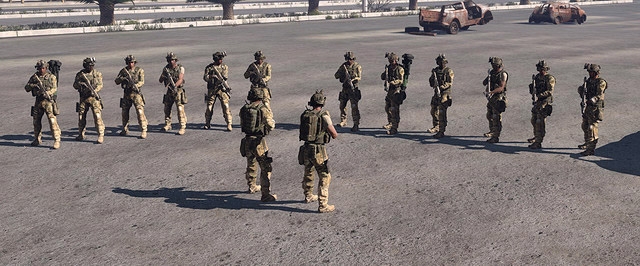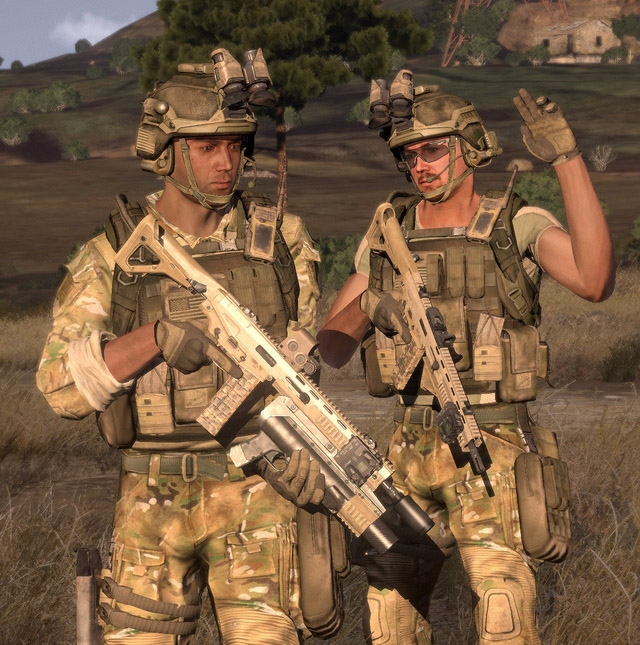Squad leading

Standard rifle squad, with Squad Leader and Medic in foreground
Squads consist of an impressive array of firepower, and are just as well-rounded as the Fireteams they are composed of. In addition to their ability to inflict significant harm, they also are accompanied by a medic who can tend to any wounds that may be received through the course of a fight. The medic acts as the second man in the two-man squad lead element, providing security for the Squad Leader when they're not tasked out with tending to wounded squad members.
The order of leadership succession in a squad goes from the Squad Leader to the first then second team leaders.
Squad leaders should not change the layout of their squad from what is on the ORBAT unless this has been cleared with the field leader.
Squad Leader ("SL") Responsibilities
The Squad Leader has similar responsibilities to the Fireteam Leader, except instead of controlling individual players, they control entire fireteams. They are tasked with leading their squad in accordance with the platoon commander's intent and direction, as well as coordinating laterally with their fellow squads. The squad leader's motto is to "Lead from the front", since they know that they cannot direct their Fireteams most efficiently if they cannot observe their movements and combat.

Squad Leader (left) and Squad Medic (right)
Squad Leaders get their direction from the platoon commander. They are expected to be able to take a broad goal set by the Platoon Commander, and turn it into a plan that they can pass down to their fireteam leaders. This includes setting rules of engagement, formations, waypoints, rally points, movement speeds, and any other relevant information.
Ensure that their team leaders and squad members know what the plan is.
Position themselves so that they can best observe their fireteams, and exercise command and control over them.
A Squad Leader who isn't staying close to their Fireteams is quickly rendered ineffective.
Squad leaders must always be with their fireteams, positioned where they can make sound and timely tactical judgments, and issue clear and appropriate orders.
Typically a Squad Leader will be just behind the front line, positioned to where they can see as much of their squad as the tactical situation allows for.
Dictate squad formations, rules of engagement, and general combat posture, adapting to the situation at hand and the Platoon Commander's guidance.
Communicate key information across to other squad leaders and up to the platoon commander.
This includes information like;
casualties incurred
enemy contacts
ammunition status
other vital pieces of information that maintain the platoon's situational awareness
Maintain situational awareness on the platoon's disposition, as well as that of the enemy.
Knowing where friendly forces are is critical to avoiding friendly fire incidents
knowing where the enemy is gives the Squad Leader important information to use in making tactical decisions.
The Squad Leader should be actively telling their squad members where friendly forces are, to ensure that the risk of blue-on-blue is minimized.
Wield their Fireteams as their weapons by directing and controlling their fire, picking out and assigning key targets, and maneuvering the Fireteams across the battlefield.
A Squad Leader who is giving good, timely orders, maneuvering his Fireteams through combat and directing their fire, does far more damage to the enemy than one who is preoccupied with his own rifle.
A Squad Leader avoids becoming personally engaged in firefights when possible, instead focusing on;
designating targets
maintaining awareness of the tactical situation
communicating with higher leadership
maneuvering the teams
directing and controlling their fires
coordinating the handling of any casualties that occur.
Know how to consolidate and reorganize teams when casualties occur.
Keep their squad tied-in with other friendly squads when moving in a platoon formation.
The Squad Leader must stay aware of how close their squad is to other squads, to ensure that dangerous gaps do not develop in the overall formation.
The tighter and more broken the terrain, the more important this becomes.
Last updated
Was this helpful?
